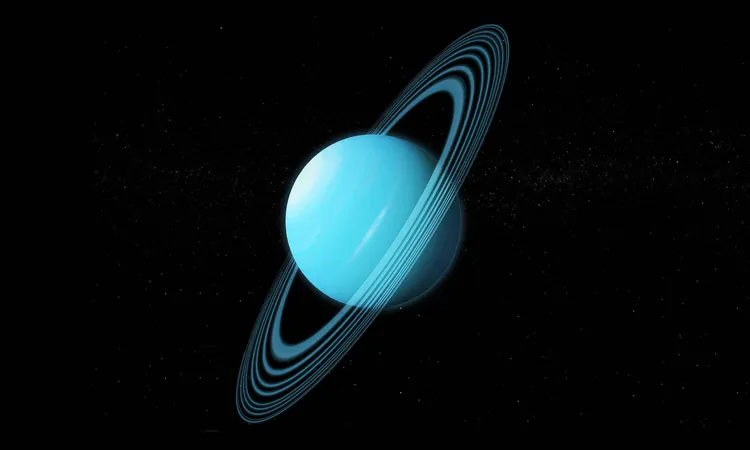
Uranus Enigma Unlocked: Four Decades After Voyager 2's Groundbreaking Visit
2024-11-23
Author: Yan
An Intriguing Overview of Uranus
Uranus, the seventh planet from the Sun, is renowned for its extraordinary tilt of approximately 98 degrees, causing it to roll along its orbital path like a bowling ball. This peculiar orientation results in extreme seasons, each lasting over 20 Earth years. The planet's striking blue-green color is attributed to the presence of methane gas in its atmosphere, which absorbs red light and reflects blue wavelengths. In addition to its 27 known moons, many named after Shakespearean characters, Uranus boasts a ring system that, while not as vibrant as Saturn's, still provides a fascinating glimpse into its celestial dynamics.
As the coldest planet in our solar system, Uranus reaches frigid temperatures of approximately -224 degrees Celsius (-371 Fahrenheit). To put it into perspective, one complete orbit around the Sun takes nearly 84 Earth years, meaning a single year on Uranus is akin to a human lifetime.
Voyager 2’s Historic Encounter
In 1986, NASA's Voyager 2 made its monumental approach to Uranus, delivering unprecedented data about this unusual planet. This flyby not only revealed new moons and rings but also posed new enigmas, particularly regarding the planet's magnetosphere—a crucial factor in understanding space weather and planetary atmospheres.
Decoding the Magnetosphere's Mysteries
Recent analyses of Voyager 2’s data have confirmed the presence of energized particles around Uranus, a phenomenon that contradicted previous theories about how such elements interact with magnetic fields. It turns out that the conditions encountered by Voyager 2 were rare, occurring only about 4% of the time due to a peculiar space weather event that temporarily compressed Uranus' magnetosphere just before the spacecraft's arrival.
Jamie Jasinski, the lead author of a new study published in *Nature Astronomy*, emphasized the significance of this timing. Had Voyager 2 arrived just days earlier or later, the data gathered would have depicted a vastly different scenario regarding Uranus' magnetic properties.
A New Understanding of Solar Winds and Radiation
Discoveries indicate that the solar wind, which continuously flows from the Sun, may play a pivotal role in shaping Uranus' magnetosphere dynamics. This solar wind event, with its increased intensity, could have driven plasma out of the magnetosphere, creating radiation belts that were previously unexplained.
Interestingly, researchers now suggest that Uranus’ five major moons could possess geological activity, continuously releasing ions into their surroundings, contrary to prior assumptions of inactivity. This revolutionary concept could reshape our understanding of the moon's interaction with the planet's magnetic field.
Looking Ahead: Future Exploration of Uranus
The urgency to deepen our exploration of Uranus has been emphasized by the National Academies' 2023 Planetary Science and Astrobiology Decadal Survey, which identifies Uranus as a critical target for upcoming NASA missions. Linda Spilker from the Jet Propulsion Laboratory reflects on the findings, noting that Voyager 2 provided a mere snapshot of Uranus' complexities, and our growing insights continue to redefine our perception of this enigmatic planet.
The Voyager Legacy Continues
Despite being billions of miles away, Voyager 2 remains a vital source of data, still communicating with Earth via NASA’s Deep Space Network. As it ventures through the interstellar medium, expected to transmit information until at least 2025, Voyager 2 stands as a beacon of scientific discovery, offering invaluable revelations about our solar system.
In summary, recent advancements have not only solved longstanding puzzles about Uranus but have also opened new avenues for exploration. Stay tuned for more awe-inspiring developments as we continue to unlock the mysteries of the cosmos!





 Brasil (PT)
Brasil (PT)
 Canada (EN)
Canada (EN)
 Chile (ES)
Chile (ES)
 España (ES)
España (ES)
 France (FR)
France (FR)
 Hong Kong (EN)
Hong Kong (EN)
 Italia (IT)
Italia (IT)
 日本 (JA)
日本 (JA)
 Magyarország (HU)
Magyarország (HU)
 Norge (NO)
Norge (NO)
 Polska (PL)
Polska (PL)
 Schweiz (DE)
Schweiz (DE)
 Singapore (EN)
Singapore (EN)
 Sverige (SV)
Sverige (SV)
 Suomi (FI)
Suomi (FI)
 Türkiye (TR)
Türkiye (TR)